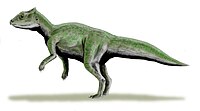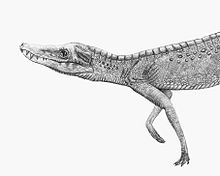Shishugou Formation
| Shishugou Formation | ||
|---|---|---|
Ma | ||
| Type | Approximate paleocoordinates 42°30′N 100°30′E / 42.5°N 100.5°E | |
| Region | Xinjiang | |
| Country | ||
| Extent | Northern Junggar Basin | |
The Shishugou Formation (
Its strata date back to the
The Wucaiwan Member, once considered a separate, underlying formation,[4] is now considered the lowest unit of the Shishugou Formation.
Lithology
At the Wuwaican locality, the formation is approximately 380 m thick, the lower 30 metres of the formation predominantly consist of conglomerate, with the majority of the formation consisting of red coloured mudstone with frequent channel/sheet sandstone lenses and occasional tuffaceous deposits.[3] It is laterally equivalent to the Qigu Formation in the southern half of the Junggar Basin.
Shishugou Formation dinosaur traps
The Shishugou Formation dinosaur traps also known as death pits or death traps are pit structures found within the formation that are noted for their fossil content.
Paleontology
These 'traps' or 'bonebeds' are unusual in that they consist of vertically stacked skeletons of numerous non-avian theropods in 1–2 metres (3.3–6.6 ft) deep pits. The pits are filled with a mix of alluvial and volcanic mudstone and sandstone and appear to have been created by the trampling and wallowing of large dinosaurs. Small theropods and vertebrates then became mired in these pits, dying and being forced deeper by the activities of the large dinosaurs and the struggles of later victims. The high quality of preservation suggests a rapid burying of the carcasses. Some scavenging of the bodies took place leading to a dispersal of body parts. Smaller vertebrates were prone to getting stuck in these mudholes, and the small ceratosaur,
Excavations since 2000 have revealed a wealth of fossils dating from a period some 165 to 155 million years ago. Palaeontologists James Clark and
Prehistoric life

At the time the area was covered by marshland, adjoined a small mountain range peppered with volcanoes, and was inhabited by dinosaurs, small crocodilians and amphibians. Currently it is a sparsely settled region of dry washes, arid badlands and dunes along the

When the site was first excavated, new species of turtles, crocodilians, pterosaurs, and early mammals were revealed. Many of these species showed the rudiments of characteristics that would later become their hallmarks. One of the first fossil skeletons exposed proved to be that of an unknown
On analysis of the rock matrix, large amounts of volcanic ash were found, hinting at eruptions during that period, the ash raining onto the marsh creating viscous mud and becoming subsequent death traps. To date three of these death pits have been located. In one pit a
Vertebrate paleofauna
Ornithischians
Undescribed stegosaur is present in the Wucaiwan member.
| Genus | Species | Stratigraphic position | Abundance | Notes | Images |
|---|---|---|---|---|---|
| " Eugongbusaurus "
|
"E. wucaiwanensis" | Upper | An unspecified basal neornithischian), previously classified as Gongbusaurus wucaiwanensis.[2] It is estimated at around 1.3 to 1.5 meters (4.3 to 4.9 ft) long.
|
||
| Hualianceratops | H. wucaiwanensis | Upper | An early ceratopsian.[7]
|
 | |
| Jiangjunosaurus | J. junggarensis | Upper | A stegosaurid reaching around 6 meters (20 feet) in length and weighed 2.5 metric tons.[8] It had three distinguishing traits: the crowns of the teeth are symmetrical and in side view wider than tall; the spine of the axis, the second neck vertebra, has a rectangular profile in side view, instead of a triangular one; and the rear neck vertebrae have large vein openings in their sides.
|
 | |
| Yinlong | Y. downsi | Upper | A very basal and most primitive ceratopsian (possibly a chaoyangsaurid). It was bipedal and had a total length of about 1.2 meters (3.9 feet) from nose to tail, and a weight of about 15 kilograms (33 pounds).[9] |  |
Pterosaurs
| Genus | Species | Stratigraphic position | Abundance | Notes | Images |
|---|---|---|---|---|---|
| Kryptodrakon | K. progenitor | Upper | A basal pterodactyloid with an estimated wingspan of 1.47 meters (4.8 feet).
|
 | |
| Sericipterus | S. wucaiwanensis | Upper | A rhamphorhynchid with a wingspan that has been estimated at least 1.73 meters.[10]
|
 |
Sauropods
Sauropods of the Shishugou Formation
| ||||||
|---|---|---|---|---|---|---|
| Genus | Species | Stratigraphic position | Material | Notes | Images | |
| Bellusaurus | B. sui | base of Upper | A short-necked sauropod only known from juvenile specimens which measured about 4.8 meters (16 feet) long.[4] |  | ||
| Fushanosaurus[11] | F. qitaiensis | Upper | Complete right femur | A titanosauriform estimated to have been approximately 98 feet long, which would then make it one of the longest known dinosaurs.
|
||
| Klamelisaurus | K. gobiensis | Wucaiwan member | A eusauropod measuring 15 meters and weighing 5 metric tons. |  | ||
| Mamenchisaurus | M. sinocanadorum | Upper | "Partial skull and skeleton."[12] | A mamenchisaurid with a remarkably long neck which made up half the total body length.[2] It is one of the largest dinosaurs known, measuring 35 meters (115 feet) in length with an 18-meter-long (59 feet) neck.
|
 | |
| Tienshanosaurus | T. chitaiensis | Upper | "Partial postcranial skeleton."[13] | A mamenchisaurid known from very few remains.[2] | ||
Theropods
Undescribed
| Genus | Species | Stratigraphic position | Abundance | Notes | Images |
|---|---|---|---|---|---|
| Aorun | A. zhaoi | Wucaiwan member | A basal alvarezsaur that was at best 1 meter (3.3 feet) long and weighed 2 kilograms (4.4 pounds) at most.[3]
|
 | |
| Guanlong | G. wucaii | Upper | A tyrannosaurs, about 3 meters (9.8 feet).[14] It has a large distinctive crest on its head, a feature seen in many primitive tyrannosaurs
|
 | |
| Haplocheirus | H. sollers | Upper | An alvarezsaur that was the largest known definite member of the superfamily, at around 2 meters long. It had an enlarged thumb claw like other alvarezsaurs, but also retained two other functional fingers, unlike more derived alvarezsaurs, where only the thumb was significantly large and clawed.[15] |
 | |
| Limusaurus | L. inextricabilis | Upper | A toothless, omnivorous Eastern Asia, including China.[16] Limusaurus had a small slender body measuring about 1.7 meters in length.
|
 | |
| Monolophosaurus | M. jiangi | Wucaiwan member | A tetanuran named for the single crest on top of its skull. It is estimated to have a length at 5.5 meters (16.4 feet), the weight at 475 kilograms.
|
 | |
| Shishugounykus | S. inexpectus | Upper | A little-known early alvarezsaur. | ||
| Sinraptor | S. dongi | Upper | A metriacanthosaurine metriacanthosaur theropod standing nearly 3 meters (9.8 feet) tall and measuring roughly 7.6 meters (25 feet) in length. |  | |
| Zuolong | Z. salleei | Upper | A basal gray wolf. The specimen known is probably from a juvenile individual and is quite complete.[17]
|
 |
Crocodylomorphs
After an overview of crocodylomorphs of the Junggar Basin, Wings et al. identified the following species from the Shishugou Formation.[18]
| Genus | Species | Stratigraphic position | Abundance | Notes | Images |
|---|---|---|---|---|---|
| Crocodyliformes indet. | Upper | A single fully articulated skeleton | Found on the same slab that also preserved the holotype and an associated specimen of Limusaurus inextricabilis[16][5] | 
| |
| Junggarsuchus | J. sloani | Upper |  | ||
| Sunosuchus | S. junggarensis | Upper | Goniopholidid | ||
| Nominosuchus | N. matutinus | Upper | Shartegosuchid
|
Mammaliamorphs
| Genus | Species | Stratigraphic position | Abundance | Notes | Images |
|---|---|---|---|---|---|
| Yuanotherium | Y. minor | Upper | A tritylodontid[19] |
See also
- Jurassic Asia
- Jurassic paleontological sites
- List of dinosaur-bearing rock formations
References
- ISBN 978-0813711942.
- ^ ISBN 0-520-24209-2.
- ^ S2CID 53538348.
- ^ ISBN 0-520-24209-2.
- ^ S2CID 131520314.
- ^ China's Junggar Basin - National Geographic
- PMID 26649770.
- S2CID 54510491.
- PMID 16901832.
- S2CID 53688256.
- ^ "A new titanosauriform dinosaur (Dinosauria: Sauropoda) from Late Jurassic of Junggar Basin, Xinjiang (In Chinese)". Global Geology. 38: 581–588. 2019.
- ^ "Table 13.1," in Weishampel, et al. (2004). Page 262.
- ^ "Table 13.1," in Weishampel, et al. (2004). Page 271.
- S2CID 4424849.)
{{cite journal}}: CS1 maint: multiple names: authors list (link - S2CID 36904501.
- ^ S2CID 4358448.
- .
- S2CID 129583852.
- .

